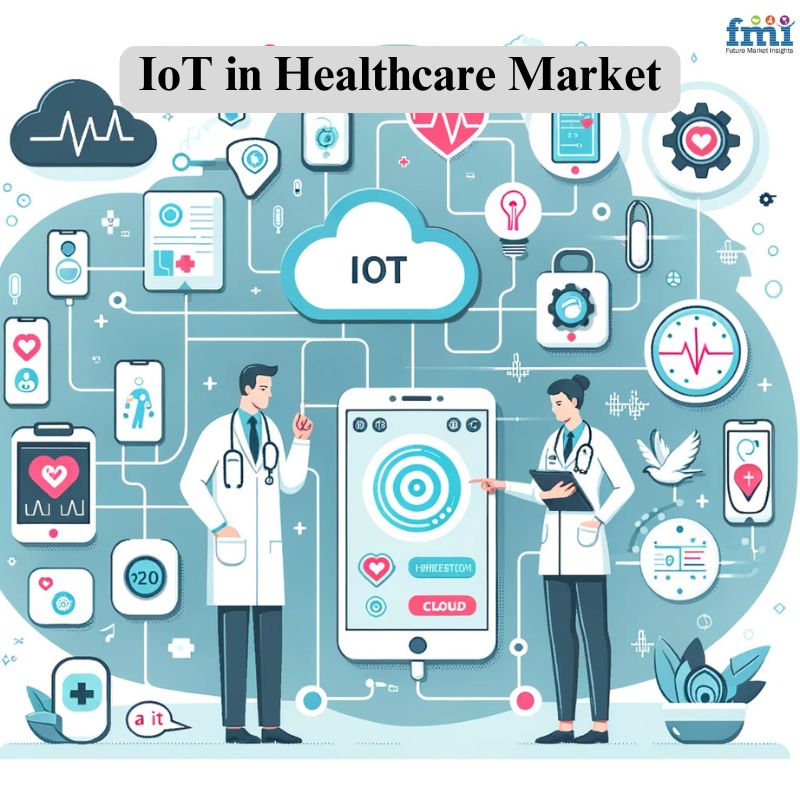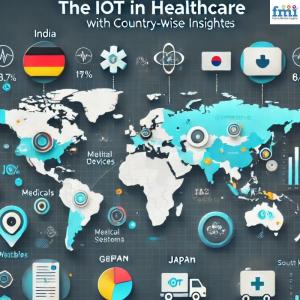
IoT in Healthcare Market Projected to Reach USD 1 Trillion by 2035 at 15.3% CAGR with AI, ML and Telehealth Advancements

Global IoT in Healthcare Market
Explore the IoT in healthcare market, growing at a 15.3% CAGR, driven by AI, ML, wearable devices, and telehealth, surpassing USD 1 trillion by 2035.
NEWARK, DE, UNITED STATES, January 16, 2025 /EINPresswire.com/ -- The global IoT in healthcare market is on a rapid growth trajectory, projected to reach USD 243.40 billion by 2025. With a CAGR of 15.3%, the market is expected to surpass USD 1 trillion by 2035. The rising adoption of connected medical devices, along with advancements in AI and machine learning, is contributing to this significant expansion. As healthcare systems become more integrated, IoT applications are enabling real-time patient monitoring, improving diagnostics, and enhancing treatment precision. This ongoing trend reflects the increasing reliance on technology to streamline healthcare delivery and improve patient outcomes.
Get Full Report Now - https://www.futuremarketinsights.com/reports/iot-in-healthcare-market
Key Trends Shaping the Market
Integration of Artificial Intelligence and Machine Learning:
AI and machine learning algorithms are significantly enhancing the capabilities of healthcare providers by enabling real-time patient monitoring and sophisticated data processing. These technologies facilitate easier patient record management and improve disease prediction through advanced analytics.
Personalized Patient Care:
The demand for personalized care has surged, leading to an increased need for medical devices equipped with advanced technologies that can tailor treatments based on individual patient data. Wearable devices that continuously monitor vital signs exemplify this trend, providing comprehensive data to healthcare professionals.
Rise of Telehealth Services:
The popularity of telehealth services has grown, especially post-pandemic, allowing clinicians to consult patients remotely. This integration with AI-driven tools reduces administrative burdens, enabling healthcare providers to focus more on patient care.
Government Support and Funding:
Increased government investments in healthcare infrastructure and technology development are propelling the adoption of IoT solutions in healthcare settings, facilitating better patient outcomes through improved monitoring and treatment options.
Growing Demand for Remote Patient Monitoring:
The rise in chronic diseases necessitates continuous monitoring, driving the demand for IoT-enabled devices that can track patient health metrics in real-time.
How is AI transforming patient care in hospitals?
AI is transforming patient care in hospitals through various innovative applications that enhance diagnostics, treatment personalization, and operational efficiency. Here are some of the key ways AI is impacting healthcare:
Enhanced Diagnostics
Improved Accuracy: AI algorithms analyze vast amounts of medical data, including imaging studies (like X-rays, MRIs, and CT scans), to identify abnormalities that may not be visible to the human eye. This capability is particularly beneficial for early detection of conditions such as cancer and cardiovascular diseases
Predictive Analytics: AI systems can predict patient outcomes by consolidating data from medical records, lab results, and imaging data, helping clinicians make informed decisions about treatment plans
Personalized Treatment Plans
Tailored Therapies: AI facilitates precision medicine by analyzing individual patient data, including genetics and lifestyle factors, to recommend the most effective treatments. This personalized approach improves treatment efficacy and reduces the likelihood of complications
Continuous Monitoring: Wearable devices powered by AI collect real-time health data (e.g., vital signs), allowing healthcare providers to monitor patients continuously and adjust treatment plans as necessary
Operational Efficiency
Streamlined Administrative Tasks: AI automates time-consuming administrative duties such as scheduling appointments and managing patient records. This reduces the administrative burden on healthcare staff, allowing them to focus more on direct patient care
Resource Optimization: AI tools can predict patient admission rates and optimize resource allocation (staffing, equipment, bed management), which enhances hospital efficiency and reduces wait times for patients
Telehealth Integration
Remote Consultations: The integration of AI in telehealth services allows clinicians to consult with patients remotely, improving access to care. AI virtual assistants can gather patient information before consultations, making the process more efficient
Follow-Up Care: AI-driven systems can send personalized follow-up messages and medication reminders to patients, helping reduce readmission rates and ensuring adherence to treatment plans
Patient Engagement
Virtual Health Assistants: AI chatbots and virtual assistants provide patients with information about their health conditions, appointment schedules, and medication management, enhancing patient engagement and satisfaction.
Health Monitoring Tools: AI applications help patients self-monitor their health conditions (e.g., diabetes management tools) by providing real-time feedback based on collected data.
Key Drivers of Market Growth
Several factors are driving the growth of the IoT in healthcare market. The integration of AI and machine learning into medical devices is transforming patient care, making disease prediction, real-time monitoring, and personalized treatment plans more efficient. With telehealth services gaining momentum, particularly post-pandemic, remote consultations and continuous patient monitoring are more accessible than ever. Moreover, the trend towards personalized care has amplified demand for advanced medical devices that can provide tailored treatment options based on individual health data.
Challenges Facing the Market
Despite its impressive growth, the IoT in healthcare market faces several challenges. Data security and privacy concerns are paramount, as healthcare organizations must comply with stringent regulations and protect sensitive patient information. The integration of various IoT devices into existing healthcare infrastructure can also be complex, requiring significant investment and interoperability across multiple systems. Additionally, there are challenges related to the training and upskilling of healthcare professionals to effectively use these advanced technologies.
Here are some of the most prominent companies in the market, as per the IoT in Healthcare Sector Outlook
Medtronic
GE HealthCare
Philips
Apple
Microsoft
Alphabet (Verily Life Sciences)
Cisco
Qualcomm
IBM Watson Health
Siemens Healthineers
Roche
Johnson & Johnson
Samsung Health
Cerner Corporation
Epic Systems
Honeywell
Fitbit (now part of Google)
Zebra Technologies
Otsuka Pharmaceutical
NantHealth
IoT in Healthcare Market Segmentation
By Component:
The global market is segmented, according to the IoT in healthcare sector analysis, into three main components: hardware, software, and services.
By Application:
In terms of application, the market is divided into several key areas, including telemedicine, medication management, clinical operations, patient monitoring, connected imaging, and various healthcare applications.
By Technology:
The market is also categorized based on technology, which includes Bluetooth-based, Wi-Fi-based, NFC-based, Zigbee-based, RFID-based, and other emerging technologies.
By End User:
Finally, the Global IoT in Healthcare market is segmented by end user, which comprises hospitals, pharmaceuticals, and clinics & laboratories.
By Region:
The market can be segmented by region, encompassing North America, Europe, Asia Pacific, Middle East and Africa, and Latin America.
Explore FMI’s Related Ongoing Coverage on Healthcare Market Insights Domain:
The global healthcare IT outsourcing market share is expected to reach a valuation of US$ 52.877 billion in 2023. Outsourcing IT solutions in the healthcare industry have emerged as an effective way to reduce rising healthcare costs while meeting the growing demand for excellent care.
The global healthcare interoperability solutions market size is forecasted to expand at 14.5% CAGR to reach a market valuation of US$ 16.2 billion by the end of 2033, up from US$ 3.7 billion that was recorded for 2022.
About Future Market Insights (FMI)
Future Market Insights, Inc. (ESOMAR certified, recipient of the Stevie Award, and a member of the Greater New York Chamber of Commerce) offers profound insights into the driving factors that are boosting demand in the market. FMI stands as the leading global provider of market intelligence, advisory services, consulting, and events for the Packaging, Food and Beverage, Consumer Technology, Healthcare, Industrial, and Chemicals markets. With a vast team of 400 analysts worldwide, FMI provides global, regional, and local expertise on diverse domains and industry trends across more than 110 countries.
Join us as we commemorate 10 years of delivering trusted market insights. Reflecting on a decade of achievements, we continue to lead with integrity, innovation, and expertise.
Contact Us:
Future Market Insights Inc.
Christiana Corporate, 200 Continental Drive,
Suite 401, Newark, Delaware - 19713, USA
T: +1-347-918-3531
For Sales Enquiries: sales@futuremarketinsights.com
Website: https://www.futuremarketinsights.com
Ankush Nikam
Future Market Insights, Inc.
+ +91 90966 84197
email us here
Visit us on social media:
Facebook
X
LinkedIn
YouTube
Other
Distribution channels: Healthcare & Pharmaceuticals Industry
Legal Disclaimer:
EIN Presswire provides this news content "as is" without warranty of any kind. We do not accept any responsibility or liability for the accuracy, content, images, videos, licenses, completeness, legality, or reliability of the information contained in this article. If you have any complaints or copyright issues related to this article, kindly contact the author above.
Submit your press release
